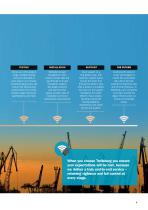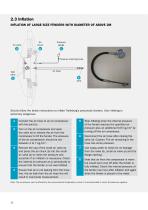 Website:
Trelleborg Marine and Infrastructure
Website:
Trelleborg Marine and Infrastructure
Group: Trelleborg
Catalog excerpts

Pneumatic Rubber Fender HANDLING, STORAGE, INSTALLATION AND MAINTENANCE MANUAL
Open the catalog to page 1
The Smarter Approach The smarter approach for a more efficient port Transferring know-how for smarter LNG Connect with The Smarter Approach By Trelleborg Marine and Infrastructure Visit: Converse: @TrelleborgMI Explore: marineandinfrastructure Discover: TrelleborgMarineandInfrastructure Materials best practice for a smarter port The demanding nature of commercial ports and terminals means you need partnership that provides much more than technically superior products and technologies. You need to work with a partner that combines best practice expertise gained through worldwide experience...
Open the catalog to page 2
Pneumatic Rubber Fender Handling, Storage, Installation and Maintenance Manual Trelleborg Marine and Infrastructure is a world leader in the design and manufacture of advanced marine fender systems. We provide bespoke solutions for large and complex projects all over the world. Best practice design and quality materials ensure a long, low maintenance service life, no matter how demanding the working and environmental conditions. All fenders are supplied fully tested and manufactured in accordance with PIANC 2002 guidelines. Our pneumatic fenders are also completely ISO17357-1:2014...
Open the catalog to page 3
A Smarter Approach at every stage A smarter approach to... CONSULTATION Consultation from the earliest project phase to ensure the optimum fender systems and marine technology solutions are specified, with full technical support from our global offices. Conceptual design in your local office – with full knowledge of local standards and regulations, delivered in your language – for optimized port and vessel solutions. Concepts are taken to our Engineering Centers of Excellence in India where our team generates 3D CAD designs, applicationengineering drawings, a bill of materials, finite...
Open the catalog to page 4
Across our entire product range, stringent testing comes as standard at every step in our in-house manufacturing process. We ensure that lifecycle and performance of our entire product range meets your specifications, and more. Dedicated project management, from solution design right the way through to on-site installation support. We design products and solutions that always consider ease of installation and future maintenance requirements. Local support on a truly global scale, with customer support teams all over the world. And this service doesn’t stop after a product is installed. You...
Open the catalog to page 5
Pneumatic Rubber Fenders FEATURES Easy and fast to deploy Trelleborg’s Pneumatic Rubber Fenders are ideal for permanent and semi-permanent fender solutions for ports as well as ship-to-ship transfers. These fenders require minimal maintenance which keeps their operational costs down. Very low reaction and full hull pressure Suitable for small and large tidal ranges Maintain high clearances between hull and structures APPLICATIONS Oil and gas tankers Fast ferries and aluminium vessels Temporary and permanent installations Rapid response and emergencies Ship-to-ship operations
Open the catalog to page 6
Types of Fenders The two most common types of pneumatic fenders that are compliant with the international standard ISO 17357-1:2014 are type I – chain-tire-net (CTN) type fenders and type II – sling type fenders. The type of fender to be used depends on its application, usage and the requirements of the facility. TYPE I: CHAIN-TIRE-NET (CTN) TYPE CTN is a lattice of tires connected by a network of longitudinal and lateral chains for extra protection to the fender body. Trelleborg’s Type I fenders use galvanized chains for greater corrosion resistance. Rubber sleeves are inserted over the...
Open the catalog to page 7
2.1 Unloading Extreme care must be taken to ensure that unloading is being carried out under close supervision of competent personnel. Follow the below instructions to unload Trelleborg’s pneumatic fenders: 1 Remove the cross beams from the top of the container. From an open-top container 2 Connect lifting slings to the shackles/ links that indicate ‘lifting points’ and gently lift the fender up with the help of a crane. 3 Move the pneumatic fender out of the container through the door and be careful not to get caught on the surrounding catch points. 4 Place the fender on a large flat area...
Open the catalog to page 9
2.2 Unpacking Unpack the fenders and inflate them within the first week of receiving them. Do not store the fenders in a deflated condition for an extended period as this will greatly reduce their service life. Sling Type Follow the below instructions to unpack Trelleborg’s pneumatic fenders: 1 The fender should be placed in an area large enough to accommodate it when fully inflated. Areas strewn with debris or near high-temperature metalwork must be strictly avoided to prevent damage to the skin of the fender. Cut and remove the ropes or bands that are wrapped around the fender. Take extra...
Open the catalog to page 10
2.3 Inflation INFLATION OF SMALL AND MEDIUM SIZE FENDERS UP TO DIAMETER 2M Air valve Valve Plastic Rotary core cap nut Pressure gauge Ball Ball valve-A valve-B Strictly follow the below instructions to inflate Trelleborg’s pneumatic fenders. Over inflating is extremely dangerous. 1 Remove the plastic cap (c) and valve core (b) from the air valve (a) at the flange opening and connect the rotary nut (d) on the air hose to the air valve of the fender. Connect the joint (h) to the air compressor. Make sure that the ball valve-A (f) and ball valve-B (g) are kept closed before connecting joint...
Open the catalog to page 11
2.3 Inflation INFLATION OF LARGE SIZE FENDERS WITH DIAMETER OF ABOVE 2M Pressure gauge Pressure checking hose Ball valve Strictly follow the below instructions to inflate Trelleborg’s pneumatic fenders. Over inflating is extremely dangerous. 1 Connect the air hose to an air compressor with the joint (e). Turn on the air compressor and open the valve (d) to release the air from the compressor to fill the fender. The pressure of the air compression should be set between 4 to 7 kg/cm2. Remove the cap of the small air valve (a) and press the air chuck (b) into the small air valve (a) to check...
Open the catalog to page 12All Trelleborg Marine and Infrastructure catalogs and brochures
-
SafePilot brochure
20 Pages
-
Docking & Mooring
88 Pages
-
Pneumatic Fender infographic
1 Pages
-
Pneumatic Fenders brochure
28 Pages
-
Fender Application Design Manual
88 Pages
-
Multipurpose and Tug Fenders
44 Pages
-
Rolling Fenders and Safety
18 Pages
-
AutoMoor Brochure
24 Pages
-
Fender Systems
86 Pages
-
DynaMoor
20 Pages
-
Bollards
28 Pages
-
Solid SmartFender Factsheet
2 Pages
-
Ship-Shore Links Factsheet
4 Pages
-
SmartDAS Factsheet
2 Pages
-
TRELLEBORG DYNAMOOR
4 Pages
-
SmartDock ® Display Board
4 Pages
-
Surface Buoyancy
24 Pages
-
SmartMoor Series II
7 Pages
-
Performance Monitoring
3 Pages
-
Universal Safety Link
3 Pages
-
TRELLEBORG’S Tugger Winch
2 Pages
-
LNG Infographic
8 Pages
-
SafePilot User Guide
30 Pages
-
Safepilot SmartPort System
16 Pages
-
Combined ESDS & SSL
3 Pages
-
Ship Shore Link System
3 Pages
-
Emergency Shutdown Link
3 Pages
-
Floating Fenders
48 Pages
-
Prelude LNG
1 Pages
-
AutoMoor Datasheet
4 Pages
-
SafePilot CAT XT System
2 Pages
-
Whitepaper - Correction Factors
10 Pages
-
Mini Guide - Foam Fenders
5 Pages
-
Buoy Range Table
2 Pages
-
Hawser Hooks
6 Pages
-
Guide - Fenders
8 Pages
-
Barometer Report 3
16 Pages
-
Barometer Report 2
7 Pages
-
lload monitoring software
2 Pages
-
lload monitoring systeme
5 Pages
-
Remote Release System
6 Pages
-
Capstans
4 Pages
-
Accessories
10 Pages
Archived catalogs
-
Docking and mooring
2 Pages






















































































